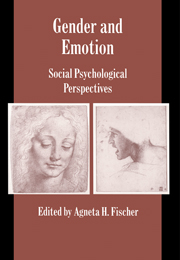Book contents
- Frontmatter
- Contents
- Preface
- Contributors
- Part I Culture, gender, and emotional beliefs
- Part II Emotion expression and communication
- 5 Gender differences in nonverbal communication of emotion
- 6 Gender and smiling: A meta-analysis
- 7 Sex differences in crying: Empirical findings and possible explanations
- 8 Masculine identity and restrictive emotionality
- Part III Distinct emotions
- Part IV Epilogue
- Indexes
- Studies in Emotion and Social Interaction
7 - Sex differences in crying: Empirical findings and possible explanations
Published online by Cambridge University Press: 20 January 2010
- Frontmatter
- Contents
- Preface
- Contributors
- Part I Culture, gender, and emotional beliefs
- Part II Emotion expression and communication
- 5 Gender differences in nonverbal communication of emotion
- 6 Gender and smiling: A meta-analysis
- 7 Sex differences in crying: Empirical findings and possible explanations
- 8 Masculine identity and restrictive emotionality
- Part III Distinct emotions
- Part IV Epilogue
- Indexes
- Studies in Emotion and Social Interaction
Summary
Crying or weeping can best be described as a typically human form of emotional expression. However, despite the vast literature on emotions and emotional disorders, this phenomenon surprisingly appears to have been neglected in behavioral science literature, as was already recognized by Borgquist (1906). Since that time no significant increase in the interest of researchers for this topic has been noted. In recent handbooks on emotions (e.g., Lewis & Haviland, 1993; Magai & McFadden, 1996; Oatley & Jenkins, 1996) hardly any attention is paid to adult crying.
The functions of crying
There is no doubt that crying is by nature a response to an emotional event, or to memories of or reflections on emotional events. The scarce literature on crying reveals the following two functions of this emotional expression: tension relief or catharsis (see, however, Cornelius, 1997) and communication, that is, making clear to others that one feels helpless and in need of comfort and support (e.g., Cornelius, 1997; Kottler, 1996). In addition, there is some evidence that crying can be used to manipulate others (Buss, 1992; Frijda, 1997; Kottler, 1996).
In current stress theory, the term “coping” refers to the behaviors and cognitions of an individual who is exposed to stressful situations, with the aim of eliminating stressors, reducing their intensity, or dampening emotional distress brought about by the confrontation with stressful events (Lazarus, 1991).
Information
- Type
- Chapter
- Information
- Gender and EmotionSocial Psychological Perspectives, pp. 143 - 165Publisher: Cambridge University PressPrint publication year: 2000
Accessibility standard: Unknown
Why this information is here
This section outlines the accessibility features of this content - including support for screen readers, full keyboard navigation and high-contrast display options. This may not be relevant for you.Accessibility Information
- 53
- Cited by
